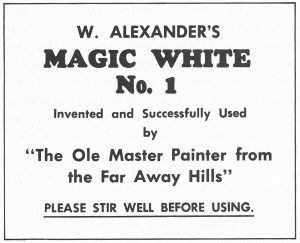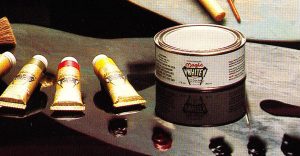
Bill struggled to make money at the beginning of his art career. Traditional methods of oil painting required days or weeks to create an oil painting. Bill could not charge a price for his paintings that compensated him for the time it took to create one. Bill needed a way to speed up the painting process. He could then sell a painting at a price people could afford. He would also be able to earn a “happy buck.”
Bill’s solution was a centuries old method of oil painting called wet-on-wet. Bill, though, took wet-on-wet one step further. He modified and innovated it. We’re going to focus on just one of Bill’s innovations right now — Magic White™. In a video posted on our website, Bill explained how he came up with the idea of Magic White™.
Why did Bill invent Magic White™?
Bill realized that he spent a lot of time mixing colors on his palette. Most of his color mixing used white paint. Bill wondered, What if there was a way to mix on the canvas rather than on the palette? What if he could cover the canvas with a thin, wet coat of white paint? He could speed up, at least, one part of the painting process. So the concept of Magic White™ was born.
Bill’s autobiography recounts his development of Magic White™. He began by using an oil based primer from the hardware store. He worried, though, that the primer would crack and yellow with age. He began to experiment first by adding more oil to regular oil paint. Then he combined extra additives to the paint including solvents. It took him a number of years of trial and error until he developed a formula he liked. Satisfied with the result, he began selling it to his students.
 Magic White™ sped up Bill’s ability to create a painting. In the “Paint with Bill” Art Course, Bill creates a detailed cloudscape in less than five minutes. Later when Bill began painting on television, Magic White™ was a big time saver. Bill only had 27 minutes to create a completed painting and every minute counted.
Magic White™ sped up Bill’s ability to create a painting. In the “Paint with Bill” Art Course, Bill creates a detailed cloudscape in less than five minutes. Later when Bill began painting on television, Magic White™ was a big time saver. Bill only had 27 minutes to create a completed painting and every minute counted.
Bill used Magic White™ for his entire career. It has been the standard for much of the wet-on-wet painting done since Bill’s death. Many paint manufacturers copied Bill’s Magic White™ formula. But there is a problem!
The Problem
The problem with Magic White™ was that it contained solvents to keep the paint thin. Wet-on-wet involves a process of stacking layers of paint one on top of another. The first layer must be thin. Solvents, though, are toxic to many people. In fact, a lot of people do not take up oil painting because of unhealthy reactions to solvents. Paint manufacturers have tried to get around this problem by creating odorless products. Unfortunately, odorless does not mean they are no longer harmful. Just because you can’t smell fumes doesn’t mean they are safe to breathe.
Alexander Art has a commitment to creating a safer oil painting environment. A few years ago we introduced an environmentally friendly brush cleaner. “How,” we wondered, “could we make Magic White™ safer?”
Next Week: The Search For A Solution


It was William Alexander who impressed me so much I had to learn his method of painting. I had been trying to teach myself how to paint and when I started watching him each week, I learned how to use Magic White and painting became so much easier. I love it and have used it in every painting I have made over the last 20 years. Thanks Bill.
Betty Kuhn-Mckenna
Being very new to painting, I am a little confused on one item. What is the main difference between gesso and magic white? In layman’s terms. Thank you.
We’re can I find Magic white paint or is only sold on line (edwardtheroux@yahoo.com) thank you for any help
nice content alexander
coincidentally, one day I told my wife; I would like to know how to do oil painting. Turned on the t.v. in 1981 and there was Bill. He said we are going to paint a tree. I followed him ever sine. There has been stints of 8 yrs. and 6 yrs. where I laid down my brushes and shouldn’t have. Now that i’m retired I am relearning. My wife just ordered the magic white for me. I’ve done 6 paintings in the past 2 months. with the first one I had very little magic white left in the can from 6 years ago. I made rustoleum and paint thinner, and suffered as it dryed rapidly. Happy to have magic white again. Istill watch Bill on youtube for hours. Always appreciated Mrs. Alexander’s poems on the back of the instruction books.
Do you magic white while still wet as I’m struggling with colours blending into one another or am I putting to much magic white on to start with.
Ron,
Months later, I just saw your question. Sorry about that. If you’d like to send photos to laurie@alexanderart.com we can see what you might be doing wrong. It could be too much Magic White, it might be thin paint going into thin paint. We’d love to help you.
Laurie
I remembered watching Alexander paint on TV.
I want to paint a scene on an interior wall (painted paneling) and not sure which paint to use, oil or acrylic.
Is Magic White used Only for oil, or can it also be used the same way with acrylic paints?
Cynthia,
Magic White is an oil-based medium, not to be used with acrylic paint. Tom Anderson paints a lot of murials. He paints them in acrylic. That is what we recommend for a wall.
Please post a photo of your finished work. We would love to see it.
Happy Painting!
Laurie
Perhaps this is silly, but I am going to “Fire in” nonetheless lol. I cant paint a painting anywhere near Bill in 27 minutes, it may take me several days even. The magic white starts to dry up and the color will no longer move, is there a way to make it wet again once its started to tack up? Thanks so much! -Travis